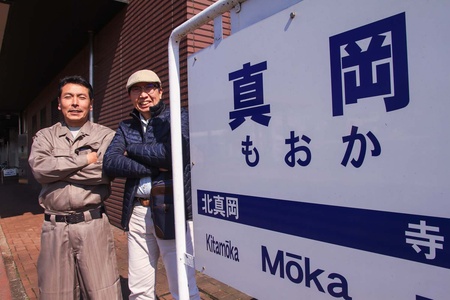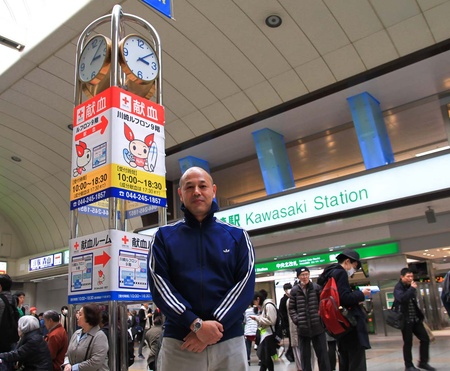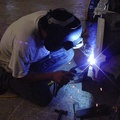MOOKA, SECOND HOME
Not everyone was prepared for the culture shock and the harsh work regime they found in Japan, which caused many to collapse emotionally. Nostalgia for their loved ones and the different environment wreaked havoc on those who were not prepared. Today the Internet allows fluid communication with relatives on the other side of the world and a lot of information on any topic in real time. It wasn't like that three decades ago.
“I remember that the contractor was concerned about these health issues, both physical and mental, so a team of counselors was created, made up of doctors and psychologists who then worked as translators, which allowed them to directly deal with each of the cases. Some were forced to return to their countries because their psychological state would not allow them to continue working,” recalls Jaime Takahashi, who arrived in Japan for the second time in June 1989 along with 35 other people, this time to work in a factory. . Years ago he had done it with a study scholarship.

He was sent to Omiya, Saitama, and was learning to weld when he was offered a position at the contractor's office in Mooka because he spoke a little nihongo . Those were the days when even translators were lacking to guide the hundreds of Latinos who arrived in Japan almost every day.
As a contractor's tantōsha (a role that combines the occupations of translator, driver, and representative of the placement agency's workers to factory bosses) for 20 years, and a resident of the city since he arrived, he has witnessed many episodes of the history of Latinos in that city. Many of them sad, especially in the first years. “It was difficult for everyone, from coexistence. Living from one day to the next sharing a small apartment with four strangers with whom we have nothing in common caused some problems,” he recalls.
For 10 years he has worked in the city prefecture as an official of the International Mooka Association, where he coordinates and supports educational and cultural initiatives of interest to foreigners. On Facebook he manages the page “Dekasegi Moka J Takahashi”, which rescues information about the first days of the presence of Latin American workers in Japan.
“30 years ago we came for economic improvement. I think that the majority have achieved that goal and were able to have something of their own or educate their children. Times have changed and we brought our families to live with us. What the second and third generations of Peruvians achieve here will also be the result of these efforts in Japanese lands,” he says.
GETTING TO KNOW THE IJIME
Mary Arakaki was probably the first Peruvian mother to feel the suffering that bullying causes in her children. He arrived in late 1988 with his 7-year-old son to visit his grandfather who lived in Kanagawa. She wanted to stay only as long as her tourist visa allowed, but they convinced her that Japan was the most appropriate place to protect herself from the serious economic crisis that was overwhelming Peru.
Already with the rest of the family in Japan, he got a place at school for the oldest of the boys and was surprised that they prohibited him from accompanying him to school. I had to go alone with the other children in the neighborhood and walk the 40 minutes to school. One day it took him longer than usual to return. He found him crying and beaten: three children had attacked him and he could not defend himself. He went to school to complain and told the teachers that if this happened again he didn't know how he would react, which scared them. His son, at that time, was the only foreigner at school. After this painful episode things changed and gradually the boy made friends and the neighborhood welcomed his family better.
He then moved to Mooka, Tochigi, where he worked in a moyashi (bean sprout) processing plant, as well as tofu (tofu) factories, and later as a caddy on golf courses. His three children were already studying.
“In Tochigi we also had problems with harassment and my children were attacked in primary school, because they were new. I had to encourage them to fight those who wanted to hurt them, because they were not used to fighting. Things got worse in high school, where there were gangs (bōsōzoku) that recruited students in the early grades. At that time, we were unaware that there were these types of groups at school and the negative influence they have. Since they are senpai , they want to convince them by giving them things and making them believe that they are part of the clan. Once again my eldest son ended up being a victim of them by refusing to join the group. This first cost him threats and then serious attacks that took him to the hospital. The environment was very dangerous, so I chose to return to Kanagawa, for safety. It was terrible. Happily, after so many years, they are all achieved and the two oldest have given me four beautiful granddaughters. I don't like many things about Japan, but I ended up adapting. And although not everything was pleasant, I think what we have been through together has been worth it to make us closer,” says Mary, who has not returned to Peru in more than 30 years.
JAPAN, AT 18
Carlos Higa arrived in Japan in September 1989, along with fifty compatriots. He evaluates his three decades in Japan in this way: “I always wonder if it was good or not to come to Japan. I say this for myself, not for others. I earned an amount of money at a very young age that I never had, but that ambition and having the security of having two or three thousand dollars every month did not allow me to think about what I wanted to do with my life and that's how the years went by. I don't deny having come, but today my friends and family in Peru are better in every way: they have studied a degree, they have their own business, etc. There was a time when I worked three months without resting a single day, not even Sundays. It was too much sacrifice. I lost many things, not just materials. I learned that just as important as 'dribbling' is planning. Today I am trying to become independent, working on my own, setting small goals for myself.” And among the things he has been doing, he has created a Facebook page (“Mooka shi Mooka shi”) with information of interest to residents of the city.
Higa was 18 years old when he started working turning lathes in an auto parts factory, Mooka, the city where he lives until now. “Youth, desire and knowing that you are earning 100 dollars a day defeated the fatigue of working twelve hours six days a week under pressure, because they demanded a lot from us. What shocked me a lot was being alone, since at the beginning we had nothing in that apartment in which six people lived; no radio or television, and many times no one to talk to at home due to different work schedules. Suddenly, I was alone in a strange country,” he says.
GRATITUDE TO JAPAN
Juan Yha was 23 years old and was beginning his professional internship as a civil engineer when he decided to come to Japan in September 1989, encouraged by what some cousins told him who already knew the “monster” inside.
“It was the opportunity to make money, but at the same time it represented a challenge, an adventure. I wanted to save for my thesis, I remember. With ten others from the group with which I arrived, I was placed in the Yorozu of Yokohama and I had a heavy job in which I did not last long. I will never forget that first day. We entered smiling that morning, and at noon no one wanted to talk. We were so tired that we didn't even want to eat... and there was still half the day left, plus overtime. Today it's funny to remember it,” he recalls.
Knowing some Japanese and English allowed him to pursue other opportunities. He studied hospitality at a high school while working as an intern in a hotel, and at the same time he had an hourly job in the city of Kawasaki as a bartender in a live-house and serving in izakaya bars and host-clubs , in order to balance the budget. . Until an employment agency enrolled him in its team as a translator, a job he has been doing since 1990 in several companies.
“Before coming, one imagines many things about Japan, but you have to be here, live the experience. And within everything these 30 years of my life have left here, I prefer to focus more on the positive. Initially we all came to raise money and return to Peru. I don't think anyone, three decades ago, said they wanted to live here. The mentality has changed and today there are many who have chosen this country to reside. In that sense, I think we must thank Japan for having welcomed us and provided opportunities. And just like what happened in Peru with the Japanese immigrants, let's aspire for our children to develop at other levels. It would also be good to reflect on what we can do, as a collective, to maintain this history of Peruvians in Japan that is now 30 years old and make it known to new generations,” he reflects.

* This article is published thanks to the agreement between the Peruvian Japanese Association (APJ) and the Discover Nikkei Project. Article originally published in Kyodai Magazine , adapted for Kaikan magazine No. 119 and for Discover Nikkei.
© 2019 Texto y fotos: Eduardo Azato



